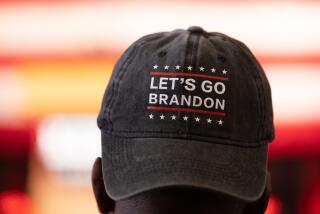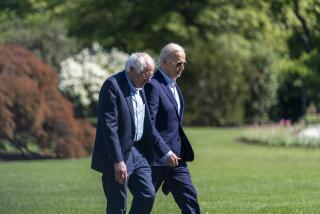Gore Deals a New Strategy to Out-Democrat Bradley
WASHINGTON — In a dizzying role reversal, Al Gore now finds himself relying on the old liberal coalition to rejuvenate a presidential campaign built around a centrist “New Democrat” agenda.
With his endorsement last week by organized labor, a new ad that invokes his long involvement in causes dear to Democratic activists and, above all, a new rallying cry that questions the partisan loyalty of rival Bill Bradley, Gore increasingly seems to be targeting his campaign toward core party constituencies such as union members and minorities.
Gore’s heightened efforts to identify himself as a populist fighter for “working families” and a more loyal Democrat than Bradley could solidify his base of support. But this effort to frame the primary race in terms of party loyalty may do nothing to diminish Bradley’s formidable appeal to less partisan voters--and might even enhance it.
And while Gore generally has not moved left in his policy positions, an increased stress on partisanship could make it more difficult for him to reach the independent voters he’ll need in the general election if he wins the nomination, strategists in both parties agree.
Above all, Gore’s new direction continues to turn the Democratic race inside out. For most of President Clinton’s two terms, Gore anticipated running in 2000 as the “New Democrat” who would mobilize a centrist constituency against a traditional blue-collar liberal such as House Minority Leader Richard A. Gephardt (D-Mo.). Instead, in key states, Bradley has captured the lion’s share of support from the college-educated, less partisan voters that the New Democrat agenda largely targets.
That’s pushing Gore to appeal to core Democrats with a Gephardt-like populist and partisan message that questions his rival’s fealty to party traditions--a message encapsulated in Gore’s refrain that Bradley did not “stay and fight” during critical confrontations with the GOP over the last 20 years.
“At the end of the day, the New Democrats seem to be relying even more on the core constituencies of the old Democratic Party, and that’s more than a tad ironic,” says Ruy Teixeira, a public opinion analyst at the Century Foundation in Washington.
Bradley Running to the Left of Gore
In some ways, Gore’s new emphasis shows how the Democratic race is being shaped by an odd mismatch between the two candidates’ constituencies and agendas.
Substantively, Bradley has been running mostly to Gore’s left--trumpeting his opposition to welfare reform, pledging to let gays serve openly in the military and promising to spend $65 billion a year to insure Americans without health care. But Bradley generally has been polling best among better-educated, moderate Democrats attracted to his outsider persona and disillusioned with the scandals surrounding Clinton.
By contrast, Gore has mostly stuck to Clinton’s “New Democrat” policy balance. While promising new spending in health care and education, Gore has pledged to keep the budget in balance and maintain the time limits that welfare reform imposes on aid to welfare recipients. Likewise, Gore did not qualify his support for free trade while winning organized labor’s endorsement last week. Today, he’s scheduled to release a program that emphasizes the responsibility of absent fathers to financially and emotionally support their children. Yet even with this centrist mix, Gore has generally been running best with core Democrats loyal to Clinton, such as African Americans, Latinos and working-class whites.
Many Democratic analysts believe the nature of his existing support has constrained Gore’s options for responding to Bradley’s rise. As Bradley has moved left, one option for Gore might have been to accuse him of leading the party back toward the agenda it offered when it lost five of the six presidential elections from 1968 to 1988. But Gore faced the risk of alienating his own liberal supporters if he attacked Bradley, for instance, over his opposition to welfare reform.
Gore advisors insist they have not ruled out painting Bradley as too liberal later on. But for their initial thrust, Gore’s campaign has chosen a message that comes at Bradley from exactly the opposite direction: questioning whether he is a reliable Democrat while portraying the vice president as the dependable champion of the party’s interests.
At the heart of this offensive has been Gore’s new refrain of “stay and fight.” Since unveiling it at a Iowa Democratic Party dinner on Oct. 9, Gore has used the phrase to convey a series of meanings--each aimed at drawing a favorable contrast with Bradley.
Most obviously, Gore has jabbed Bradley for failing to “stay and fight” at two key junctures: when the former New Jersey senator voted for President Reagan’s budget cuts in 1981 and when he decided to retire from Congress in 1996 and flirt with an independent presidential bid--a period when Clinton and other Democrats were locked in fierce combat with the new GOP congressional majority.
But Gore is also using the phrase to try to redefine himself as less Ed McMahon and more Harry S. Truman--less the perennial second banana that many Americans consider any vice president, and more a scrappy, populist fighter for average families. Gore drew upon the phrase in that way when he collected his endorsement from the AFL-CIO in Los Angeles last week. “When everything that matters to working families is at stake . . . we have only one choice, and that is to stay and fight,” he said. Without directly using the phrase, Gore’s new television ad, released Monday, similarly portrays him as a longtime fighter who has “stood against the tide” to defend “working families.”
Finally, the “stay and fight” phrase allows Gore to cast himself as someone with the grit to claw through what looks like a difficult general election against the GOP--and to subtly question whether Bradley has that toughness.
So far, Bradley has largely brushed off Gore’s new thrust. While aides defend Bradley’s partisan credentials--noting that he campaigned for 46 Democratic candidates in 1996--both the candidate and his advisors have mostly refused to engage Gore, believing that voters this year will recoil from political attacks.
Moreover, Bradley strategists believe Gore’s efforts to paint his challenger as an unreliable Democrat is unlikely to dissuade the independent voters who now like Bradley. Indeed, some in Bradley’s camp believe Gore’s more partisan direction suggests he has at least temporarily abandoned hope of winning back those voters--an assessment shared by some analysts. “In that group, it would be the sort of thing Bradley would wear on his sleeve,” says John Zogby, an independent pollster.
‘Stay and Fight’ Unlikely to Endure
Gore aides say the “stay and fight” mantra is unlikely to be their “never-ending touchstone” in the campaign against Bradley. But its early prominence echoes the strange twist of the 1992 Democratic race.
Like Gore now, Clinton expected to be the centrist champion of moderate and well-educated Democrats against a more liberal opponent like former New York Gov. Mario M. Cuomo, who would target the traditional Democratic coalition. Instead, in the early going, the late former Sen. Paul E. Tsongas of Massachusetts sliced off the upscale vote with an economically conservative and socially liberal agenda. That drove Clinton to pound Tsongas with a populist message that resonated with core Democratic constituencies and powered the Arkansas governor to the nomination.
But Paul Begala, who as a Clinton aide helped shape that 1992 message, believes Bradley presents a more difficult target for Gore than Tsongas did for Clinton. Tsongas opened himself to counterattack with an economic agenda that included support for cuts in entitlement spending and a social agenda that included opposition to the death penalty. Clinton criticized him on both counts.
Bradley generally shares Tsongas’ social liberalism (though Bradley supports the death penalty). But, unlike Tsongas’ economic agenda, Bradley’s emphasis on expanding access to health care and combating child poverty speaks to traditional Democratic concerns.
“It seems that the shot Clinton had at Tsongas was a lot clearer than the shot Gore has at Bradley,” says Teixeira.
*
Times political writer Mark Z. Barabak contributed to this story.
More to Read
Get the L.A. Times Politics newsletter
Deeply reported insights into legislation, politics and policy from Sacramento, Washington and beyond. In your inbox three times per week.
You may occasionally receive promotional content from the Los Angeles Times.










